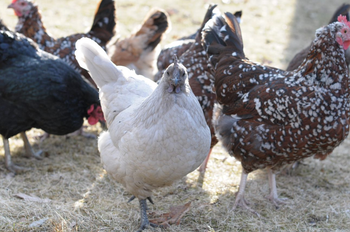Whenever a group of animals live together, they rely on a system of social hierarchy in order to coexist peacefully, and chickens are no different. Every flock establishes a pecking order, a dominance status amongst individuals in the flock. Learning how chickens establish their flock pecking order and knowing some tips for helping them maintain that pecking order can help you raise a happy and peaceful flock.
What is the Chicken Pecking Order?
Every group of birds has a social order and hierarchy within the group to maintain harmony. Without a hierarchy, birds will constantly fight or squabble for access to mates, food, water, or roosting places. And when it comes to a flock of chickens, this hierarchy is called “the pecking order.”
The pecking order is the dominance hierarchy within a flock. This system allows each individual to coexist peacefully with other members of the flock. Establishing the pecking order is a natural behavior needed for both the survival and stability of the flock.
What is the Purpose of a Pecking Order?
As the name implies, a chicken pecking order provides order or organization to the social structure of the flock. This structure affects nearly every aspect of a hen’s everyday life.
The flock pecking order plays several important roles for a flock of chickens, including:
- Social Structure & Individual Roles: Each bird has a role that will benefit the flock and ensure its survival.
- Safety: There is safety in numbers for prey animals like chickens, but only if all the birds are coexisting peacefully with each other. By having established rules, maintaining peace is easier.
- Flock Dynamics: A flock that can coexist peacefully with each other will be less stressed and have minimal fights or bullying issues.
- Reduces Competition: Each bird within the flock knows when it can access food and water and where it can roost at night.
The pecking order allows each bird to know its boundaries within the social structure of the flock. A chicken will know what behaviors it can get away with and what actions are expected of it depending on where it ranks in the pecking order.
Chicken Pecking Order Roles

Being a dominance hierarchy system, the pecking order is composed of several different roles. Each member of the flock fits into their own position depending on their rank.
#1. Head Hen
The head hen is at the top of the pecking order. This is the dominant hen in the flock.
The head hen is not only the boss of the flock, but she is also responsible for the safety of the flock, finding food for the flock, and keeping order within the flock. She must enforce her position as the head hen to prevent fights from breaking out amongst other hens within the flock.
#2. Middle Roles
If the head hen is at the top position in the flock, the rest fall into a spectrum of dominance below. Each hen below the head hen establishes their place in the pecking order, often at incremental and subtle levels. The closer in rank a hen is to the head hen, the more flock members she has below her that she can boss around. Naturally, hens with dominant personalities will be higher up in the pecking order than hens with more laid-back personalities.
#3. The Bottom Hen
The chicken at the bottom of the pecking order has the lowest status in the flock. Sometimes there is a group of hens who are considered at the bottom of the pecking order and other times it is just a single hen. The hen at the bottom of the pecking order has no one below her to boss around. She will be the last one to access food or water and will usually not be permitted to choose the favorite roosting or nesting spots.
In a well-structured flock, the bottom hen is not necessarily the hen to be pitied. A well-structured flock will ensure that all members of the flock have access to food, water, and a safe roosting spot no matter where they fall in the pecking order. If a hen is last in the pecking order, she may just have to wait until the higher-ranking hens have had a meal and a spot to roost.
How Does a Hen Wind Up at the Bottom of the Hierarchy?
Hens at the bottom of the pecking order are usually subordinate or have laid-back personalities. New birds who are added to an established flock will start at the bottom of the pecking order. If the new birds have dominant personalities, they may work their way up the pecking order through subtle dominance moves.
Where Do Roosters Fall in the Pecking Order?

So far we have only mentioned hens’ roles within the pecking order, so where do roosters fit in? Roosters are completely separate from the hens’ pecking order. If a rooster is present in a flock, he is automatically considered at the top of the entire flock’s pecking order, however, amongst the hens, there will still be a head hen, middle hens, and a bottom hen.
Even though there is still a head hen within the flock, the rooster has huge shoes to fill and the ultimate say over what the flock does. He is in charge of flock protection, finding food and water, keeping peace amongst the hens, and ensuring all the hens find a safe place to roost at night. He also gets breeding rights to any hen he wants, which is usually the hens lower in the pecking order.
How Does a Flock with Multiple Roosters Fair?
In a flock with multiple roosters or if several roosters are housed together, the roosters will form their own pecking order separate from the hens. Just like with the hens, there will be a head rooster with the other roosters falling in line below him.
Rooster fights occur when a subordinate rooster wants to challenge a more dominant rooster for a higher position in the pecking order.
How the Pecking Order is Established

The pecking order begins when a flock is put together, no matter their age or the number of individuals. The process slightly varies depending on the circumstances, though.
From Chickhood
When chickens are raised together from a young age, the pecking order is established gradually and peacefully. Female chicks with dominant behaviors are respected by the other chicks and rank higher in the pecking order. The dominant female chick will usually be the boldest and bravest chick in the brood.
There may be some minor squabbles as the young birds reach adolescent age, but that is to be expected as each bird establishes its rank in the pecking order. However, the pecking order is usually established by the time the young birds have grown in their first set of juvenile feathers.
The order will remain the same until a subordinate hen thinks she can rank up if new birds are added to the group, or if a death or removal occurs.
Baby Roos, Too!
Roosters who are raised together as youngsters will often have a stronger pecking order established and will be less likely to challenge each other as adults, which can prevent serious fights.
The Subtle Ways Chickens Establish Order
While the complete details of how the pecking order is established are not fully understood, we do know that both a chicken’s body language and physical actions, like pecking or sparing, can help it establish a status in the pecking order. Chickens (and chicks) can size up other members of the flock and compare their own abilities to determine if they can rank higher in the pecking order.
Other Factors In Flock Hierarchy
There are also several factors that can affect the stability and establishment of the pecking order within a flock:
- Flock Size: Flocks of less than 20 birds often have a more stable pecking order with less aggressive behaviors and bullying problems.
- Personality: A more dominant hen will rank higher up in the pecking order than laid-back hens and a flock of dominant individuals will have a more structured, rigid pecking order.
- Breed: The personality of a chicken sometimes depends on its breed, light chicken breeds tend to be more assertive and dominant than heavier chicken breeds. (Learn more about chicken breeds for first-time flock owners)
- Age: In general, younger birds start off at the bottom of the pecking order but may work their way up in status the longer they are with the flock.
Keep in mind that the pecking order changes anytime a bird passes away or is re-homed from the flock and whenever new birds are added to the flock.
How to Handle Pecking Order Problems

The pecking order is generally established and maintained peacefully within a flock. However, anything that causes a change in the flock can result in an upset of the flock’s pecking order, including bad behaviors such as bullying and fighting.
Sometimes a flock can work out its own pecking order problems when a change occurs. If a rooster is present, he often works to maintain peace and order within the flock even when an upset in the pecking order occurs. He helps the hens adjust to a new pecking order and will dispel any fights or bullying amongst the hens.
However, there may be times when you have to step in to prevent bad behaviors from getting too serious. Here are some ways you can help prevent or deal with pecking order problems in the flock:
Proper Integration
If you are adding new birds to an established flock, make sure you follow proper integration methods, including keeping your new birds visible to the flock while keeping them safe. Proper integration allows the pecking order to be peacefully rearranged between old birds and new birds.
Quarantine Sick Birds
Weakness isn’t tolerated in the flock due to the flock’s instinctual need for survival. Remove injured or sick birds who might get picked on by birds higher up in the pecking order.
Death/Loss
When a chicken passes away, a few minor squabbles may occur as hens determine who moves up. Just keep an eye out for any bullying or fighting.
Bullying
Any hen who decides to bully other flock members for food, water, or space can become a problem in the pecking order. Quarantine the bully hen or the hen who is being bullied depending on the situation. You may also want to investigate why a hen is getting bullied if she is being picked on by multiple other hens.
Plenty of Space
Make sure the coop and enclosure are spacious enough for the size of your flock. This allows each bird to have a ‘personal bubble’ and allows subordinate hens to adequately move out of the way of dominant hens.
When providing your girls with Grubblies and other snacks, be sure to spread them out, so every hen has the opportunity to enjoy them!
Proper Coop & Run Design
The coop should have plenty of feeders, waterers, roosts, and nesting boxes to allow all the hens access to what they need, no matter where they are in the pecking order. The more access there is to basic survival needs (food, water, roosts), the less competition must take place amongst flock members.
Fights
Fights may occur if any of the problems mentioned previously are not addressed. Fights amongst roosters, especially if they haven’t been raised together, can also occur if there are not enough hens or space for each rooster. You may need to intervene if a fight becomes a battle royale. Roosters can help control fights amongst hens. If you do have to intervene, quarantine any injured birds and take reintegration slowly if you are reintroducing the bird back to the flock.
A Proper Pecking Order = Peaceful Flocks

Understanding chicken pecking order behavior allows you to be more prepared to handle issues when they arise. This can be especially beneficial as you help your flock navigate situations such as when a bird is removed or when new birds are added to the flock. Helping your backyard flock maintain a stable pecking order will result in peaceful and productive chickens!






















